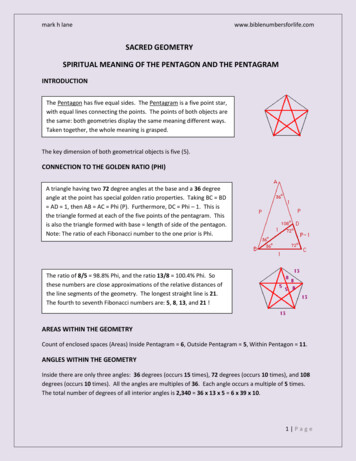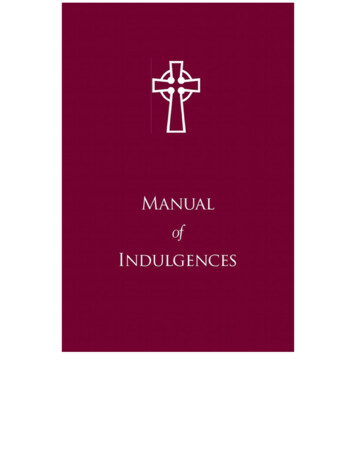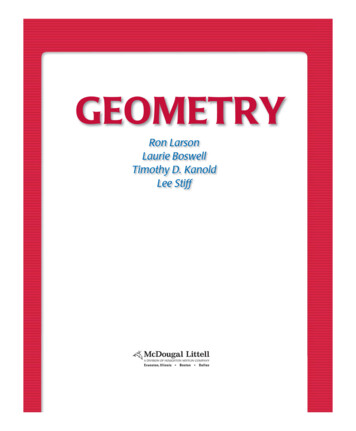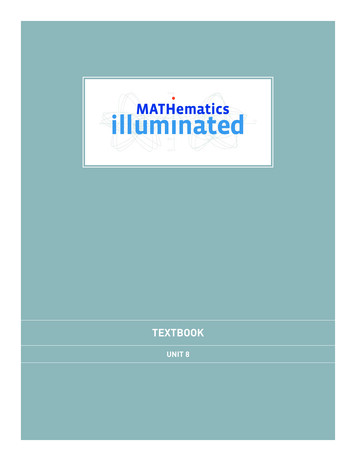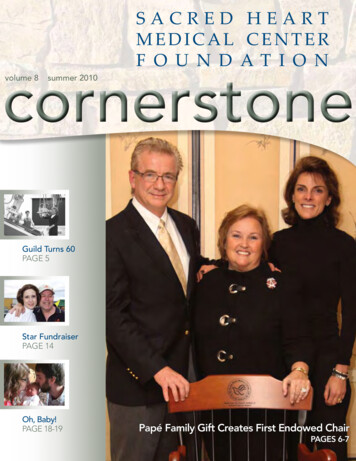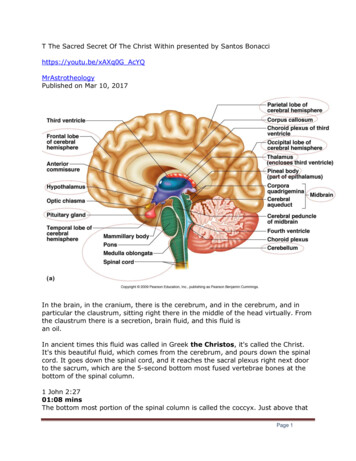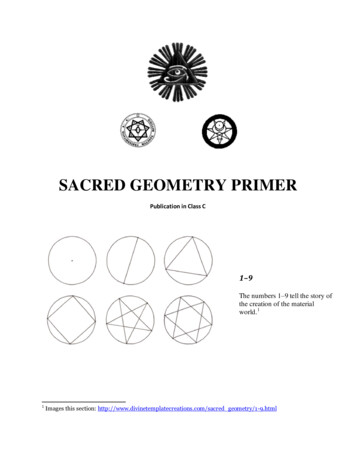
Transcription
SACRED GEOMETRY PRIMERPublication in Class C1–9The numbers 1–9 tell the story ofthe creation of the materialworld. 11Images this section: http://www.divinetemplatecreations.com/sacred geometry/1-9.html
1The 1 is the point in the circle; representative of Kether on the Tree-of-Life. Thepoint at its center is that singularity in the whole (circle) of the Universe and the oneness fromwhich the whole of creation emanates. The circle is the foundation from which all the otherforms are built. Crowley notes in the Book of Thoth:The Qabalists expanded this idea of Nothing, and got a second kind of Nothing which they called "Ain Soph"-"Without Limit".(This idea seems not unlike that of Space.) They then decided that in order to interpret this mere absence of any means ofdefinition, it was necessary to postulate the Ain Soph Aur-"Limitless Light". By this they seem to have meant very much whatthe late Victorian men of science meant, or thought that they meant, by the Luminiferous Ether. (The Space-Time Continuum?)All this is evidently without form and void; these are abstract conditions, not positive ideas. The next step must be the idea ofPosition. One must formulate this thesis: If there is anything except Nothing, it must exist within this Boundless Light; within thisSpace; within this inconceivable Nothingness, which cannot exist as Nothing-ness, but has to be conceived of as a Nothingnesscomposed of the annihilation of two imaginary opposites. Thus appears The Point, which has "neither parts nor magnitude, butonly position".But position does not mean anything at all unless there is something else, some other position with which it can be compared.One has to describe it. The only way to do this is to have another Point, and that means that one must invent the number Two,making possible The Line.2The 2 is the line; the connection of two points that divides the circle, as a cellsplits in reproduction, and creation begins. Two is the duality that is the nature of the Universewherein we dwell. Note that in the Qabalah, it is the second letter that is the foundation uponwhich the world is built.Moving onto the next number, Crowley notes:
But this Line does not really mean very much, because there is yet no measure of length. The limit of knowledge at this stage isthat there are two things, in order to be able to talk about them at all. But one cannot say that they are near each other, or that theyare far apart; one can only say that they are distant. In order to discriminate between them at all, there must be a third th ing. Wemust have another point. One must invent The Surface; one must invent The Triangle. In doing this, incidentally, appears thewhole of Plane Geometry. One can now say, "A is nearer to B than A is to C".3The 3 is the triangle and as the first shape to create a surface, represents themovement away from one-dimensional reality to two-dimensional reality. Note the trianglerepresents the strongest structure in nature. Philosophically, it represents the dialectic; point,counter-point and conclusion.4The 4 is the square, which offers support and stability through its even, balancedshape. It is the fourth point; representing the solid as a departure is made from two into threedimensional reality. This is reflected in a four-fold nature (the space-time continuum) on theEarth with: 4 seasons, 4 directions, 4 phases of the Moon, 4 elements (Earth, Air, Fire, Water).5The 5 is the pentagram (an ancient symbol of regeneration and transformation)and a fifth principal; postulated as motion. It is also a symbol of the human form, with head,arms, and legs outstretched, welcoming experience. It is through our 5 senses that we navigatethe material world.
6Movement implies consciousness; represented by the sixth Sefira (Tiphareth) onthe Tree-of-Life. The 6 is the Star of David, two perfectly balanced, interlocking equilateraltriangles. In Occult science, it gives us the axiom: ‗As above, so below‘; the uniting of spiritualplane with the material plane. It is the number of God (1) in man (5). Crowley states this clearlyin his essay:[The fifth point; motion] implies the idea of Time, for only through Motion, and in Time, can any event happen. Without thischange and sequence, nothing can be the object of sense. (It is to be noticed that this No.5 is the number of the letter He' in theHebrew alphabet. This is the letter traditionally consecrated to the Great Mother. It is the womb in which the Great Father, who isrepresented by the letter Yod which is pictorially the representation of an ultimate Point, moves and begets active existence).There is now possible a concrete idea of the Point; and, at last it is a point which can be self-conscious, because it can have aPast, Present and Future. It is able to define itself in terms of the previous ideas. Here is the number Six, the centre of the system:self-conscious, capable of experience.77 (Sat, the Essence of Being itself) is the most sacred of numbers; represented incosmology by the seven sacred planets and reflected into the seven days of the week. The 7relates to cycles of time and the movement of the sun and the planets as seen from Earth. Sevenis also the sacred vibration found in the numeration of the chakras and the musical scale.8The 8 (Chit, Thought, or Intellection) is the octagon, the intermediate formbetween the circle (Heaven) and the square (Earth). As the 4 doubled, it is the number ofascension above the material world through spiritual perspective. The 8th step on the musicalscale is the octave, which brings harmonic resonance and a sense of fulfillment.
9The 9 (Ananda; translated as Bliss, being the pleasure experienced by Being in thecourse of events.) is the completion of the creative cycle; represented by the Astral Plane Magick.It brings attainment, compassion, and vision for the future through the wisdom gleaned from thejourney through the other numbers. However the 9 is not an endpoint, but merely the closing ofthe circle, carrying us back to the 1 to begin the next evolution.General FiguresThe SphereWhile the sphere may be one of the simplest forms in sacred geometry, it is also the containerthat can hold all of the other forms. All measurements are equal in a sphere. It is a figure that iscomplete in its entirety. The earth, a seed, and an atom are all spheres.The sphere looks like the surface of a ball.The sphere has been cut in half to show that it is not solid.Bands of the sphere have been removed.The CircleA circle is another simple form found in sacred geometry. The circle is two dimensional and is asymbol of oneness. The ratio of the circumference of a circle to its diameter is called Pi. Pi is anirrational number and never ends nor does it ever repeat. It is infinite.
The Single Point is the first archetype of SacredGeometry. It is directly related to unity consciousnessor Oneness. undivided God Mind.The Single Point is the absolute root mentalconcept.the simplest idea possible. It is literally TheFirst Dimension. the omnipresent / omnipotentcenter.Single Pointedness is the root of all holisticthinking. THE ALL IS ONE.Single Pointedness or Oneness, is that which is beondDualityThe two dimensional Universe begins in thedivision of The Single Point. This is The GreatMystery of Sacred Geometry: The Single Pointmagically divides and becomes The Two PointsThe Universe is created by this division: unitybecomes duality. This is the great miracle andmystery. Suddenly, Point A. is here and Point B.is there.These two points, this first duality, marks the firstarchitectural relationship of the Universe andcreates the first abstract unit of measure, iespace. The Second Dimension literally begins atthis conceptual level: The Two PointsThe tremendous energies contained within this firsttwo dimensional relationship of the Universe (TheTwo Points) manifests as a duality of motion: straightline motion (from Point A. to Point B.) and rotationalmotion (Point B. around Point A.). This dualmovement is called The Radius/Arc.This is the conceptual Big Bang. All the variousenergies of the universe trace to the play between theRadius and the Arc. The Radius/Arc is Yin andYang. Light and Dark. Left and Right. Father andMother. etc. All manifestations of duality trace toThe Radius/Arc.
The timeless relationship forever held within TheRadius/Arc (expressed scientifically as Pi - 3.1416.)is THE root mathematical formula and visuallyunfolds to become the first enclosed form of SacredGeometry,. The Circle .The Circle is unity. Oneness. It is the twodimentional manifestation of single pointedness.undivided God Mind.The Circle is. THE ALL. This is the essence ofMandala; The Circle holds ALL.Definition: Pi: The ratio of the circumference of thecircle to its diameter: a transcendental number havinga value to eight places of 3.14159265. For practicalpurposes, the value of Pi is 3.1416.The first Icon (The Circle) is created by rotating pointB. around point A. (the yellow circle).But The Two Points, are perfect twins with equalpotentials, and Point A. can also rotate around pointB. using the original radius.This natural polality, this reversal of rolls, producesanother circle (the violet one).These two circles create the second enclosed form(overlaping) of Sacred Geometry entitled The TwoCircles Of Common Radius.These two overlapping circles with a common radius,create the third enclosed form of Sacred Geometry.The ancients called this archetype The Vesica Piscis.(black shape)ALL the dimentional forms of this cosmos evolvefrom this football like shape. literaly ALL form.The Vesica Piscis is literally the womb of theuniverse. the ever unfolding Mother of SacredGeometry.
In addition to The Vesica Piscis, The Two Circles OfCommon Radius create two new points at theirintersections (C. & D.).The play of Father/Mother points (A. and B.) createthe first children of the universe: The twins (points C.& D.). And the magnification continues.Rotating the first two points (A. & B.) around thesenew points (C. & D.) creates two additional circlesand four additional Vesica Piscis. Now we have Fourcircles of common radius and Five Vesica Piscis (seeFig 8).The two new circles also create four more points (E.F. G. & H.), and another enclosed form of SacredGeometry we call, The Petal (the white shape at thecenter).This is the germ of The Creation Pattern, as all of thenecessarry forms are now in place: Parents (circles 1& 2) and children (circles 3 & 4). This is the essenceof family revealed in Sacred Geometry. the familyheart in the form of a petal.And the magnification is about to explode!
Striking more circles aroundthe new points (E. F. G. &H. ) compounds the formsand creates a never endinggrid of Circles, VesicaPiscis, and Petals entitledNature's First Pattern. Thisis an ever evolving twodimensional pattern which,at the conceptual level,circumnavigates theuniverse.Nature's First Pattern isTHE creation pattern.There are an infinite numberof sub patterns and forms tobe discovered withinNature's First Pattern, andthe study of these unlimitedpossibilities IS the root twodimensional study of SacredGeometry.The PointThe point is found at the center of the sphere or the circle. All measurements must either beginwith the point or pass through the point. It is the beginning and it is the end. In sacred geometrythe center point is thought to be the place creation began.
The Square Root of 2The square root of 2 is an irrational number. When a square with sides that measure one unit isdivided diagonally, the square root of 2 is the length of the diagonal. Like Pi, square root of 2never ends. The total of the square root of 2 equals more than half of itself. The Square Root of 2: A web page that shows the square root of 2 to 1 million digitscompleted at Nasa.The Golden RatioThe golden ratio, or phi, is the unique ratio in which the ratio of the larger portion is equal to theratio of the smaller portion. The golden ratio is another irrational number. It is usually roundedto 1.618. It is also known as the golden mean, divine proportion, or golden section. The goldenratio has been used since ancient time in architecture of buildings.The golden ratio, also known as the divine proportion, golden mean, or golden section, is anumber often encountered when taking the ratios of distances in simple geometric figuressuch as the pentagram, decagon and dodecagon. It is denotedabbreviation of the Greek "tome," meaning "to cut")., or sometimest (which is aThe term "golden section" (goldene Schnitt) seems to first have been used by Martin Ohm inthe 1835 2nd edition of his textbook Die Reine Elementar-Mathematik (Livio 2002, p. 6). Thefirst known use of this term in English is in James Sulley's 1875 article on aesthetics in the9th edition of the Encyclopedia Britannica. The symbol ("phi") was apparently first used byMark Barr at the beginning of the 20th century in commemoration of the Greek sculptorPhidias (ca. 490-430 BC), who a number of art historians claim made extensive use of thegolden ratio in his works (Livio 2002, pp. 5-6).has surprising connections with continued fractions and the Euclidean algorithm forcomputing the greatest common divisor of two integers. It is also a so-called Pisot Number.Given a rectangle having sides in the ratio , is defined such that partitioning the originrectangle into a square and new rectangle results in a new rectangle having sides with a rati. Such a rectangle is called a golden rectangle, and successive points dividing a goldenrectangle into squares lie on a logarithmic spiral. This figure is known as a whirling square.The legs of a golden triangle (an isosceles triangle with a vertex angle of ) are in a golderatio to its base and, in fact, this was the method used by Pythagoras to construct . The ratof the circumradius to the length of the side of a decagon is also ,
Bisecting a (schematic) Gaullist cross also gives a golden ratio (Gardner 1961, p. 102).Euclid ca. 300 BC defined the "extreme and mean ratios" on a line segment as the lengthssuch that(Livio 2002, pp. 3-4). Plugging in,and clearing denominators gives(Incidentally, this means that is a algebraic number of degree 2.) So, using the quadraticequation and taking the positive sign (since the figure is defined so that (Sloane's A001622).Exact trigonometric formulas for include The golden ratio is given by the infinite series 1),
(B. Roselle). Another fascinating connection with the Fibonacci numbers is given by theinfinite seriesA representation in terms of a nested radical is(Livio 2002, p. 83).is the "most" irrational number because it has a continued fraction representation(Sloane's A000012; Williams 1979, p. 52; Steinhaus 1999, p. 45; Livio 2002, p. 84). Thismeans that the convergents are given by the quadratic recurrence equationwith X1 1, which has solutionwhere F2 is the nth Fibonacci number. As a result,as first proved by Scottish mathematician Robert Simson in 1753 (Wells 1986, p. 62; Livio2002, p. 101).
Let the continued fraction of be denoted and let the denominators of theconvergents be denoted , , ., . As can be seen from the plots above, the regularity inthe continued fraction of means that is one of a set of numbers of measure 0 whosecontinued fraction sequences do not converge to the Khinchin constant or the Khinchin-Lévyconstant.The golden ratio has Engel expansion 1, 2, 5, 6, 13, 16, 16, 38, 48, 58, 104, . (Sloane'sA028259).The golden ratio also satisfies the recurrence relationTakingh 1 gives the special caseTreating ( ) as a linear recurrence equationin(h) h, setting(0) 1 and(1) , and solving givesas expected. The powers of the golden ratio also satisfywhere is a Fibonacci number (Wells 1986, p. 39).The sine of certain complex numbers involving gives particularly simple answers, forExample (D. Hoey, pers. comm.). A curious (although not particularly useful) approximation due to DBarron is given bywhere is Catalan's constant and is the Euler-Mascheroni constant, which is good to twodigits.
In the figure above, three triangles can be inscribed in the rectangle A B C D of arbitraryaspect ratio 1: r such that the three right triangles have equal areas by dividing A B and B Cin the golden ratio. Then which are all equal.The substitution map00110Givesgiving rise to the sequence(Sloane's A003849). Here, the zeros occur at positions 1, 3, 4, 6, 8, 9, 11, 12, . (Sloane'sA000201), and the ones occur at positions 2, 5, 7, 10, 13, 15, 18, . (Sloane's A001950).These are complementary Beatty sequences generated by and . The sequence alshas many connections with the Fibonacci numbers.
Steinhaus (1983, pp. 48-49) considers the distribution of the fractional parts of in theintervals bounded by 0, 1 /h, 2/h, ., (h-1)/h, 1, and notes that they are much moreuniformly distributed than would be expected due to chance (i.e., is close to anequidistributed sequence). In particular, the number of empty intervals for h 1, 2, ., aremere 0, 0, 0, 0, 0, 0, 1, 0, 2, 0, 1, 1, 0, 2, 2, . (Sloane's A036414). The values of forwhich no bins are left blank are then given by 1, 2, 3, 4, 5, 6, 8, 10, 13, 16, 21, 34, 55, 89,144, . (Sloane's A036415). Steinhaus (1983) remarks that the highly uniform distributionhas its roots in the continued fraction for.hThe sequence {frac (x )}, of power fractional parts, where is the fractional part, isequidistributed for almost all real numbers x 1, with the golden ratio being one exception.Salem showed that the set of Pisot numbers is closed, with the smallest accumulation point ofthe set (Le Lionnais 1983).SEE ALSO: Beraha Constants, Decagon, Equidistributed Sequence, Euclidean Algorithm, FiveDisks Problem, Golden Angle, Golden Gnomon, Golden Ratio Conjugate, Golden Rectangle,Golden Triangle, Icosidodecahedron, Noble Number, Pentagon, Pentagram, Phi NumberSystem, Phyllotaxis, Pisot Number, Power Fractional Parts, Ramanujan Continued Fractions,Rogers-Ramanujan Continued Fraction, Secant Method.According to legend, the Greek Philosopher Pythagoras discovered the concept of harmonywhen he began his studies of proportion while listening to the different sounds given off whenthe blacksmith‘s hammers hit their anvils. The weights of the hammers and of the anvils all gaveoff different sounds. From here he moved to the study of stringed instruments and the differentsounds they produced. He started with a single string and produced a monochord in the ratio of1:1 called the Unison. By varying the string, he produced other chords: a ratio of 2:1 producednotes an octave apart. (Modern music theory calls a 5:4 ratio a "major third" and an 8:5 ratio a"major sixth".) In further studies of nature, he observed certain patterns and numbersreoccurring. Pythagoras believed that beauty was associated with the ratio of small integers.
Astonished by this discovery and awed by it, the Pythagoreans endeavored to keep this a secret;declaring that anybody that broached the secret would get the death penalty. With this discovery,the Pythagoreans saw the essence of the cosmos as numbers and numbers took on specialmeaning and significance.The symbol of the Pythagorean brotherhood was the pentagram, in itself embodying severalGolden Means.The Greeks, who called it the Golden Section, based the entire design of the Parthenonon this proportion.The Greeks knewit as theGolden Sectionand used it for beautyand balance in thedesign of architecturePhidias (500 BC - 432 BC), a Greek sculptor and mathematician, studied phi andapplied it to the design of sculptures for the Parthenon.Porch of Maidens, Acropolis, Athens
Euclid proved that the diagonals of the regular pentagon cut each other in "extreme and meanratio", now more commonly known as the golden ratio. Here we represent the golden ratio byphi. Fn is the nth Fibonacci number.
The Square Root of 3 and the Vesica PiscisThe square root of 3 is a positive real number. When it is multiplied by itself it equals 3. Thevesica picis is the name for the almond shaped area that is created when two circles of the sameradius which intersect so that each circle lies within the circumference of the other. Thegeometric ratio of the almond space area is the square root of 3. It is considered to be the symbolfor Jesus, part of the Ark of the Covenant along with other sacred meanings.The square root of 3 is the positive real number that, when multiplied by itself, gives thenumber 3.The first sixty significant digits of its decimal expansion are:1.73205 08075 68877 29352 74463 41505 87236 69428 05253 81038 06280 5580.The rounded value of 1.732 is correct to within 0.01% of the actual value.The VESICA PISCISThe oval form of the VIII symbol is of great significance and has been known for many centuries as the VesicaPiscis, or fish's bladder, probably to conceal its true meaning.If we go back to the early stages of symbolism we find the circle used to represent eternity, and to man's conception,there are two eternities; that of the ages past, and that of the future. Two equal circles would symbolize these infiniteperiods of time and their intersection forms a cavity, which represents that attainment, which is the aim and object ofevery man's sojourn on this earth, and which in Christian symbolism, is called the birth and life of Christ in the soul.The Vesica Piscis is an almost universal symbol for the Christ and this accounts for the use of the oval form on sealsof ecclesiastical institutions.
The early Christians were anxious to include symbols of their religion in their cathedrals and churches, and this isthe reason for the rise of Gothic architecture in which the windows were built in a pointed form to include thissymbol of the Christ.As the new covenant of the Avatar Jesus is said to have superseded that of Moses, so do we find the Christiandegrees in Masonry beyond the craft or universal degrees, and in the same way Gothic architecture came after thesquare or Norman type.The diagram shown above is the figure for the first proposition of the first book of Euclid, and all the subsequentpropositions depend upon this fundamental one, which is to describe an equilateral triangle on a given line. Whendescribed in this way, the triangle forms a fitting symbol of the Christian Trinity.If we enclose the Vesica Piscis in a rectangle, and divide that rectangle into three equal parts as shown in Fig. 2, wefind that the ratio of the sides of one of the smaller triangles is equal to the ratio of the sides of the whole rectangle.In other words, the ratio of AB to AD is the same as the ratio of AD to AC, which ratio is that of 1 to the square rootof 3. This is very important and significant fact and makes the symbol particularly referable to the Triune God.This fact was evidently known to the builders of the Middle Ages for we find that the naves of many of the oldcathedrals and churches were built with their sides in this same proportion. Rosslyn Chapel, in England is a famousexample of this ratio.SpiralsThere are a number of different types of spirals. There are flat spirals, 3-D spirals, right-handedspirals, left-handed spirals, equi-angular spirals, geometric spirals, logarithmic spirals andrectangular spirals. The most well known spiral is that of the nautilus shell. All spirals have twothings in common: expansion and growth. They are symbols of infinity.Equiangular SpiralA equiangular spiral and its secants.
HistoryWant to learn differential equations? Our conceptual approach is your best bet. Visit DifferentialEquations, Mechanics, and ComputationThe investigation of spirals began at least with the ancient Greeks. The famous EquiangularSpiral was discovered by Rene Descartes, its properties of self-reproduction by Jacob Bernoulli(1654-1705) (aka James or Jacques) who requested that the curve be engraved upon his tombwith the phrase ―Eadem mutata resurgo‖ (―I shall arise the same, though changed.‖) [Source:Robert C Yates (1952)]The equiangular spiral was first considered in 1638 by Descartes, who started from the property s a.r. Evangelista Torricelli, who died in 1647, worked on it independently and used for adefinition the fact that the radii are in geometric progression if the angles increase uniformly.From this he discovered the relation s a.r; that is to say, he found the rectification of the curve.Jacob Bernoulli, some fifty years later, found all the ―reproductive‖ properties of the curve; andthese almost mystic properties of the ―wonderful‖ spiral made him wish to have the curve incisedon his tomb: Eadem mutata resurgo — ―Though changed I rise unchanged‖. [source: E HLockwood (1961)]DescriptionEquiangular spiral describes a family of spirals of one parameter. It is defined as a curve that cutsall radial line at a constant angle.It also called logarithmic spiral, Bernoulli spiral, and logistique.Explanation:1. Let there be a spiral (that is, any curve r f[θ] where f is a monotonic inscreasing function)2. From any point P on the spiral, draw a line toward the center of the spiral. (this line is called theradial line)3. If the angle formed by the radial line and the tangent for any point P is constant, the curve is aequiangular spiral.
A example of equiangular spiral with angle 80 .A special case of equiangular spiral is the circle, where the constant angle is 90 .Equiangular spirals with 40 , 50 , 60 , 70 , 80 and 85 . (left to right) Equiangular SpiralFormulasLet α be the constant angle.Polar: r E (θ * Cot[α]) equiangular spiral.gcfParametric: E (t * Cot[α]) {Cos[t],Sin[t]}Cartesian: x 2 y 2 E (ArcTan[y/x] Cot[α] )
PropertiesPoint Construction and Geometric SequenceLength of segments of any radial ray cut by the curve is a geometric sequence, with a multiplierof E (2 π Cot[α]).Lengths of segments of the curve, cut by equally spaced radial rays, is a geometric sequence.The curve cut by radial rays. The length of any green ray's segments is geometric sequence. Thelengths of red segments is also a geometric sequence. In the figure, the dots are points on a 85 equiangular spiral.CatacausticCatacaustic of a equiangular spiral with light source at center is a equal spiral.Proof: Let O be the center of the curve. Let α be the curve's constant angle. Let Q be thereflection of O through the tangent normal of a point P on the curve. Consider Triangle[O,P,Q].For any point P, Length[Segment[O,P]] Length[Segment[P,Q]] and Angle[O,P,Q] is constant.(Angle[O,P,Q] is constant because the curve's constant angle definition.) Therefore, by argumentof similar triangle, then for any point P, Length[Segment[O,Q]] Length[Segment[O,P]]*s forsome constant s. Since scaling and rotation around its center does not change the curve, thus thelocus of Q is a equiangular spiral with constant angle α, and Angle[O,Q,P] α. Line[P,Q] is thetangent at Q.
Equiangular Spiral CausticCurvatureThe evolute of a equiangular spiral is the same spiral rotated.The involute of a equiangular spiral is the same spiral rotated.Left: Tangent circles of a 80 equiangular spiral. The white dots are the centers of tangentcircles, the lines are the radiuses. Right: Lines are the tangent normals, forming the evolute curveby envelope. Equiangular Spiral Evolute
RadialThe radial of a equiangular spiral is itself scaled. The figure on the left shows a 70 equiangularspiral and its radial. The figure on the right shows its involute, which is another equiangularspiral.InversionThe inversion of a equiangular spiral with respect to its center is a equal spiral.
PedalThe pedal of a equiangular spiral with respect to its center is a equal spiral.Pedal of a equiangular spiral. The lines from center to the red dots is perpendicular to thetangents (blue lines). The blue curve is a 60 equiangular spiral. The red dots forms its pedal.Pursuit CurvePersuit curves are the trace of a object chasing another. Suppose there are n bugs each at a cornerof a n sided regular polygon. Each bug crawls towards its next neighbor with uniform speed. Thetrace of these bugs are equiangular spirals of (n-2)/n * π/2 radians (half the angle of the polygon'scorner).Left: shows the trace of four bugs, resulting four equiangular spirals of 45 . Above right: sixobjects forming a chasing chain. Each line is the direction of movement and is tangent to theequiangular spirals so formed.
Spiral in natureSpiral is the basis for many natural growths.Seashells have the geometry of equiangular spiral. See: Mathematics of Seashell Shapes.A cauliflower (Romanesco broccoli) exhibiting equiangular spiral and fractal geometry. (Photoby Dror Bar-Natan. Source)Spirals Belousov's Brew. A recipe for making spiraling patterns in chemical reactions.Equiangular spiral. Properties of Bernoulli's logarithmic 'spiralis mirabilis'.Fermat's spiral and the line between Yin and Yang. Taras Banakh, Oleg Verbitsky, and YaroslavVorobets argue that the ideal shape of the dividing line in a Yin-Yang symbol is formed, not fromtwo semicircles, but from Fermat's spiral.
Fourier series of a gastropod. L. Zucca uses Fourier analysis to square the circle and to make anodd spiral-like shape.The golden bowls and the logarithmic spiral.Golden spiral flash animation, Christian Stadler.Graphite with growth spirals on the basal pinacoids. Pretty pictures of spirals in crystals. (Apinacoid, it turns out, is a plane parallel to two crystallographic axes.)Helical Gallery. Spirals in the work of M. C. Escher and in X-ray observations of the sun's corona.Mathematical imagery by Jos Leys. Knots, Escher tilings, spirals, fractals, circle inversions,hyperbolic tilings, Penrose tilings, and more.Log-spiral tiling, and other radial and spiral tilings, S. Dutch.Looking at sunflowers. In this abstract of an undergraduate research paper, Surat Intasanginvestigates the spiral patterns formed by sunflower seeds, and discovers that often four sets ofs
Geometry we call, The Petal (the white shape at the center). This is the germ of The Creation Pattern, as all of the necessarry forms are now in place: Parents (circles 1 & 2) and children (circles 3 & 4). This is the essence of family revealed in Sacred Geometry. the family heart in t
